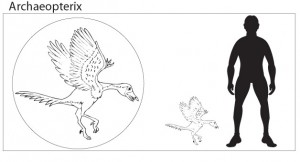Understanding Archaeopteryx – Fossil Bone Study shows Slow Growth Rate
Archaeopteryx – New Study casts doubt on Avian Lineage
A new study carried out by American scientists with support from other teams of palaeontologists in China and Germany has cast doubt over just how closely Archaeopteryx may have been to the true origin of birds. This new research published in the on line scientific journal PloS One (Public Library of Science), suggests that the metabolism and subsequent growth rate of this Jurassic creature was perhaps more reminiscent of the growth rate expected of a dinosaur than to a modern bird.
In a microscopic study of several Archaeopteryx fossils and other extinct creatures such as some of the ancient birds from the Liaoning Formation of China, images taken of the ancient cells and blood vessels inside the bones of Archaeopteryx show slow growth. This Jurassic animal may have taken years to mature and reach adult size. This pattern of ontogeny (growth) is similar to what dinosaurs had. In contrast, modern birds grow rapidly and mature in a matter of weeks.
Think of the birds in your garden or neighbourhood, you may have seen blackbirds, sparrows, and thrushes all nesting in the Spring and by late Summer the offspring are not much smaller than their parents. Modern birds (Neornithes), grow and mature very quickly. Most reptiles grow much slower, from this study it seems that evidence from the fossilised bones of Archaeopteryx indicate that this feathered creature, claimed to be the first bird and ancestral to all birds, grew at the same speed expected of a dinosaur, not at the same rate as your garden sparrow.
An Illustration of Archaeopteryx
Picture credit: Everything Dinosaur
Importantly, this research indicates that rapid bone growth, a trait common to all living birds was absent from the first birds. Rapid growth and maturation was not necessary for avian dinosaur flight.
This new paper follows the recent of announcement of the discovery of several feathered dinosaurs that pre-date the 150 million-year-old Archaeopteryx, providing evidence that creatures like Archaeopteryx may have evolved from feathered dinosaurs.
To view an article about feathered dinosaurs: Older than Archaeopteryx – Supporting Evidence of Birds evolving from Feathered Dinosaurs.
The paper co-authored by a number of palaeontologists including Gregory Erickson, an Associate Professor at Florida State’s Department of Biological Science supported by scientists at the Institute of Vertebrate Palaeontology and Palaeoanthropology (IVPP) in Beijing, compares the microscopic analysis of the long bones in various Archaeopteryx fossils with extant birds as well as theropod dinosaurs and birds such as the primitive Confuciusornis from the Cretaceous of China.
Dr Erickson stated that there was already evidence to support the theory that birds are in fact dinosaurs, but this paper attempted to answer the question: – “Just how dinosaur-like, or even bird-like was the first bird? [Archaeopteryx]“.
A Cast of an Archaeopteryx Fossil on Display
Picture credit: Everything Dinosaur
There has been considerable debate over how well this crow-sized creature could fly. Some scientists have even speculated that this early bird may not actually have been capable of powered flight, perhaps gliding from tree to tree. However, studies carried out by scientists at the Natural History Museum in London, seemed to indicate that Archaeopteryx possessed and excellent sense of balance and had the faculties required to produce and control powered flight. In addition, research has indicated that the structure of the inner ear of Archaeopteryx was more bird-like than reptilian.
To read an article on the London research: Let’s hear it for Archaeopteryx.
Commenting on the ontogeny of birds, Dr Erickson stated:
“Living birds mature very quickly. That’s why we rarely see baby birds among flocks of invariably identical-size pigeons. Slow-growing animals such as Archaeopteryx would look foreign to contemporary bird-watchers”.
Similar microscopic bone studies were carried out on the 130 million-year-old fossils of Confuciusornis. This phase of the project was supervised by scientists from the IVPP. It was concluded that the confuciusornithids were the first known birds to show a transition to the rapid growth rates associated with modern bird species. Not only was the jay-sized flyer Confuciusornis more advanced anatomically than Archaeopteryx (the development of a pygostyle rather than a long, cumbersome tail is evidence of this), but it seems that the growth rate of these two creatures was also very different. More advanced bird fossils from approximately 100 million years ago, show bones well supplied with blood vessels and were probably faster growing than the confuciusornithids.
It seems that the bird cladogram and the evolutionary path taken by our feathered friends is turning out to be every bit as complex as first thought when Huxley back in the 19th century put forward the theory of a link between Dinosauria and Aves.
Visit Everything Dinosaur’s award-winning website: Everything Dinosaur.



